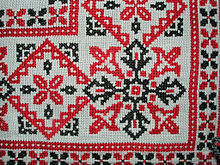
Ideas from mathematics have been used as inspiration for fiber arts including quilt making, knitting, cross-stitch, crochet, embroidery and weaving. A wide range of mathematical concepts have been used as inspiration including topology, graph theory, number theory and algebra. Some techniques such as counted-thread embroidery are naturally geometrical; other kinds of textile provide a ready means for the colorful physical expression of mathematical concepts.
Quilting
Main article: quiltThe IEEE Spectrum has organized a number of competitions on quilt block design, and several books have been published on the subject. Notable quiltmakers include Diana Venters and Elaine Ellison, who have written a book on the subject Mathematical Quilts: No Sewing Required. Examples of mathematical ideas used in the book as the basis of a quilt include the golden rectangle, conic sections, Leonardo da Vinci's Claw, the Koch curve, the Clifford torus, San Gaku, Mascheroni's cardioid, Pythagorean triples, spidrons, and the six trigonometric functions.
Knitting and crochet

Knitted mathematical objects include the Platonic solids, Klein bottles and Boy's surface. The Lorenz manifold and the hyperbolic plane have been crafted using crochet. Knitted and crocheted tori have also been constructed depicting toroidal embeddings of the complete graph K7 and of the Heawood graph. The crocheting of hyperbolic planes has been popularized by the Institute For Figuring; a book by Daina Taimina on the subject, Crocheting Adventures with Hyperbolic Planes, won the 2009 Bookseller/Diagram Prize for Oddest Title of the Year.
Embroidery

Embroidery techniques such as counted-thread embroidery including cross-stitch and some canvas work methods such as Bargello make use of the natural pixels of the weave, lending themselves to geometric designs.
Weaving
Ada Dietz (1882 – 1981) was an American weaver best known for her 1949 monograph Algebraic Expressions in Handwoven Textiles, which defines weaving patterns based on the expansion of multivariate polynomials.
J. C. P. Miller (1970) used the Rule 90 cellular automaton to design tapestries depicting both trees and abstract patterns of triangles.
Spinning
Margaret Greig was a mathematician who articulated the mathematics of worsted spinning.
Fashion design
The silk scarves from DMCK Designs' 2013 collection are all based on Douglas McKenna's space-filling curve patterns. The designs are either generalized Peano curves, or based on a new space-filling construction technique.
The Issey Miyake Fall-Winter 2010–2011 ready-to-wear collection designs from a collaboration between fashion designer Dai Fujiwara and mathematician William Thurston. The designs were inspired by Thurston's geometrization conjecture, the statement that every 3-manifold can be decomposed into pieces with one of eight different uniform geometries, a proof of which had been sketched in 2003 by Grigori Perelman as part of his proof of the Poincaré conjecture.
See also
References
- Ellison, Elaine; Venters, Diana (1999). Mathematical Quilts: No Sewing Required. Key Curriculum. ISBN 1-55953-317-X..
- Henderson, David; Taimina, Daina (2001), "Crocheting the hyperbolic plane" (PDF), Mathematical Intelligencer, 23 (2): 17–28, doi:10.1007/BF03026623, S2CID 120271314}.
- Osinga, Hinke M.; Krauskopf, Bernd (2004), "Crocheting the Lorenz manifold" (PDF), Mathematical Intelligencer, 26 (4): 25–37, doi:10.1007/BF02985416, S2CID 119728638.
- belcastro, sarah-marie; Yackel, Carolyn (2009), "The seven-colored torus: mathematically interesting and nontrivial to construct", in Pegg, Ed Jr.; Schoen, Alan H.; Rodgers, Tom (eds.), Homage to a Pied Puzzler, AK Peters, pp. 25–32.
- Bloxham, Andy (March 26, 2010), "Crocheting Adventures with Hyperbolic Planes wins oddest book title award", The Telegraph.
- Gillow, John, and Bryan Sentance. World Textiles, Little, Brown, 1999.
- Snook, Barbara. Florentine Embroidery. Scribner, Second edition 1967.
- Williams, Elsa S. Bargello: Florentine Canvas Work. Van Nostrand Reinhold, 1967.
- Dietz, Ada K. (1949), Algebraic Expressions in Handwoven Textiles (PDF), Louisville, Kentucky: The Little Loomhouse, archived from the original (PDF) on 2016-02-22, retrieved 2007-09-27
- Miller, J. C. P. (1970), "Periodic forests of stunted trees", Philosophical Transactions of the Royal Society of London, Series A, Mathematical and Physical Sciences, 266 (1172): 63–111, Bibcode:1970RSPTA.266...63M, doi:10.1098/rsta.1970.0003, JSTOR 73779, S2CID 123330469
- Catharine M. C. Haines (2001), International Women in Science, ABC-CLIO, p. 118, ISBN 9781576070901
- "Space-Filling Curves". DMCK. Retrieved 15 May 2015.
- McKenna, Douglas (24 July 2007). "The 7 Curve, Carpets, Quilts, and Other Asymmetric, Square-Filling, Threaded Tile Designs". Bridges Donostia: Mathematics, Music, Art, Architecture, Culture. The Bridges Organization. Retrieved 15 May 2015.
- McKenna, Douglas (26 Nov 2023). "Designing Symmetric Peano Curve Tiling Patterns with Escher-esque Foreground/Background Ambiguity". Bridges Leeuwarden: Mathematics, Music, Art, Architecture, Culture. The Bridges Organization. Retrieved 26 Nov 2023.
- Barchfield, Jenny (March 5, 2010), Fashion and Advanced Mathematics Meet at Miyake, ABC News.
Further reading
- belcastro, sarah-marie; Yackel, Carolyn, eds. (2007). Making Mathematics with Needlework: Ten Papers and Ten Projects. A K Peters. ISBN 978-1-56881-331-8.
- Grünbaum, Branko; Shephard, Geoffrey C. (May 1980). "Satins and Twills: An Introduction to the Geometry of Fabrics". Mathematics Magazine. 53 (3): 139–161. doi:10.2307/2690105. hdl:10338.dmlcz/104026. JSTOR 2690105.
- Taimina, Daina (2009). Crocheting Adventures with Hyperbolic Planes. A K Peters. ISBN 978-1-56881-452-0.
External links
- Mathematical quilts
- Mathematical knitting
- Mathematical weaving
- Mathematical craft projects
- Wooly Thoughts Creations: Maths Puzzles & Toys
- Penrose tiling quilt
- Crocheting the Hyperbolic Plane: An Interview with David Henderson and Daina Taimina
- AMS Special Session on Mathematics and Mathematics Education in Fiber Arts (2005)
| Textile arts | ||
|---|---|---|
| Fundamentals |  | |
| History of ... | ||
| Regional and ethnic | ||
| Related | ||
| Glossaries | ||
